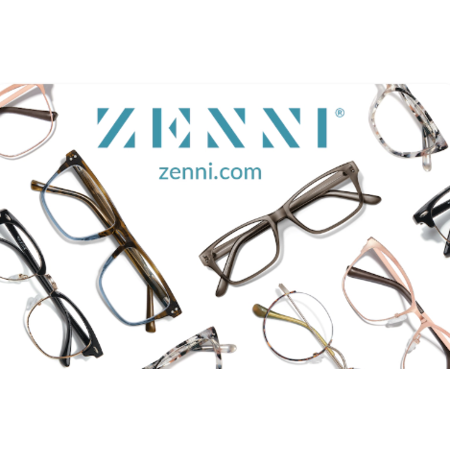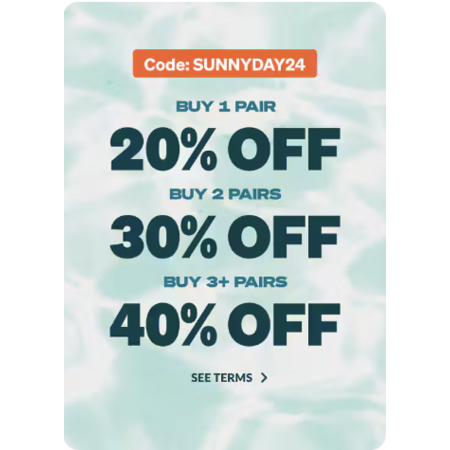Zenni Optical offers
Up to 40% Off select
Regular Priced Zenni Optical Glasses (minimum $40 purchase required) when you apply promo code
SUNNYDAY24 in cart.
Shipping is free on $25+ orders for Zenni Rewards members (
free to join).
Thanks to Global Mod
pur for finding this deal.
- Additional Savings: American Express via Amex Offers is offering select American Express Cardholders $15 Statement Credit back on $50+ Zenni orders (other offers may be available and will vary by account).
Available discounts (with code
SUNNYDAY24, some exclusions apply):
- 20% Off One pair of glasses
- 30% Off Two pairs of glasses
- 40% Off Three or More pairs of glasses
Categories:






Leave a Comment
Top Comments
1. The prescription is critical.
For the younger, a single prescription is fine.
(General mid range)
Eyeball muscles can still focus near and far with correction well.
As one gets older, you'll get far sighted, and might need two, three prescriptions.
Eye muscles can't focus at all ranges well even with a single correction.
(Close/reading, mid-range, far/driving)
For example, a prescription for reading/phones/pc use will not be good for driving exams, shooting at the range, sports.
The prescription with all two, three sets of numbers are written on 1 piece of paper.
At some point, you may need progressive or bifocal glasses. (Cheap enough to try bifocals at zenni to see, as well....) or change pairs of glasses daily.
Doctors today love to go crazy with astigmatism correction, but this can introduce funny optical aberrations. A great doc will spend lots of time to optimize this for you, even using a non-optimal correction so what you subjectively see looks best to you (not to the machine).
2. PD, distance between pupils is critical.
They usually don't write it on the prescription, but you can get them to measure twice to make sure.
There's apps at glassesusa.com and I think zenni that'll measure with a phone to double check.
3. Zenni founder I believe
https://eyeque.com/
Measure everything at home with a eye measurement device.
4. Look at lens materials and abberations. Your choice will greatly affect what you see.
Higher abbe value = lower aberration
Basic 1.5 lens will be thicker than the other plastic lens types, but have the lowest chromatic aberration.
https://th.bing.com/th/id/OIP.YzR...ImgDe
https://cdn.shopify.com/s/files/1...1649446846
If you look at objects with a new perception glasses and things still look fuzzy or weird, low abbe lens material can be the cause.
At zenni, 1.5 plastic is the cheapest...and despite the edge thickness vs other choices, still the "clearest" choice available on the market.
Imo, acceptable thickness up to -4 prescriptions.
5. Width of head vs width of frame.
If the eyeglass frame is too small, expect pinching and issues.
6. Wider + taller lenses give a better view, but also heavier if you have a strong prescription.
So trade off between turning your head a bit more to see things vs weight.
Most drive, so wider but shorter lenses better than taller and slimmer to see cars and pedestrians coming at you from the sides.
7. Sports etc - at some point, contacts/lasix better. Otherwise, sports goggles that don't move like some basketball players wear.
8. The super visual picky will see funny changes in the focus simply turning their head slightly left or right while looking at a chart in front of them.
Expensive digital lenses that map the entire field of vision and carve out a lens optimized for each point is one fix.
This also for people where a -2.25 or -2.50 prescription isn't working and they need a -2.36, for example.
9. KICK the kids OUTDOORS!!
https://pubmed.ncbi.nlm
Nearsightedness rates INCREASE as kids stay indoors more each day.
1, 2+ hours outdoors with sunlight helps prevent strong nearsightedness from developing.
(And strong nearsightedness leads to the development of other health problems later....)
10. Everyone BUY a HDTV, stick it 10+ feet away, and connect that to your computer, tablet, and phone to use as an external monitor for long periods of surfing and gaming.
Better to have the head up and eyes focused mid range all day working from home, doing homework, etc than head down and focusing too close.
The headaches, backaches, and pain from head down all day is real.
If you don't know your preferred style, I suggest stopping by a local glass shop (e.g., LensCrafters). Most places won't mind you browsing the glasses. Some shops are very busy and won't approach you unless you ask for help or sit down.
When you look at the glass frames, please check inside the frame line. You will see tiny numbers such as 56◻ 36 138. These numbers indicate the following: 56mm is the lens width (from right to left), 36mm is the bridge width (the distance between the two lenses), and 138mm is the temple length (the entire frame from left to right). You can use the model number to search for the frames online. Generally, the heaviest frames are made of thick plastic, while the lightest ones are made of titanium.
Based on my experience, Jenni frames are decent, but if you have a very complex prescription, I do not recommend them as they may not handle it well. There are many complaints from people with complex prescriptions about their lenses. However, if it's just a single vision with not too complex adjustments, they handle it very well.
Additionally, many frames they offer are not significantly different from local glass shop models. The $7 frames are often the same as the 2-for-$79 frames, with the primary difference being whether they are wholesale without a brand or branded. However, if you want something of higher quality, go for their premium series. Their high-quality, high-priced frames can sometimes be even better than those you buy at a local store for $150 or $200. Most of the money you pay goes to the factory to ensure you get good quality frames. For example, their cheapest plastic frame might cost $3-$4, as they are mass purchasers of frames. You can get these for $8 from Jenni or $40 from a local store with some type of brand marks and mark-ups.
Luxottica now owns Essilor, one of the largest lens producers in the world. They also purchased the insurance company EyeMed, which has about 50 million users annually and is the second-largest eye insurance company in North America. Additionally, Luxottica owns multiple local glass stores, continually acquiring more to build their eyewear empire.
Now, if you go to a doctor affiliated with LensCrafters, use EyeMed insurance, purchase glasses from LensCrafters, and opt for Transitions coating, all your money circulates within the Luxottica-Essilor empire.
Despite being a European company, most of their earnings come from North America, which is quite interesting. Essentially, most of the money you spend on eyewear will circulate around Luxottica. About 80% of branded glasses are Luxottica, so even if you don't use their shops, you'll likely still be paying them. Many coatings, like Transitions, are Essilor, and many lenses used by shops and labs are made by Essilor, ensuring you pay them one way or another. Moreover, many doctors, hospitals, opticians, and ophthalmologists use machines made by Essilor or based on Essilor's technology. (Look closer at the machines when you visit an eye doctor's office, and you'll see a big sticker saying "Essilor.")
It's not just a monopoly; they've built a formidable eyewear empire.
58 Comments
Sign up for a Slickdeals account to remove this ad.
Edit: just checked, counts for frames *and* lenses. Rocking deal.
Sign up for a Slickdeals account to remove this ad.
TIA
Our community has rated this post as helpful. If you agree, why not thank ultimatewarrior
Would be great to combine with this deal.
so, I would suggest contact their support to see they will take it,
and if not, just order one again, and return the one you've ordered
Sign up for a Slickdeals account to remove this ad.
Leave a Comment